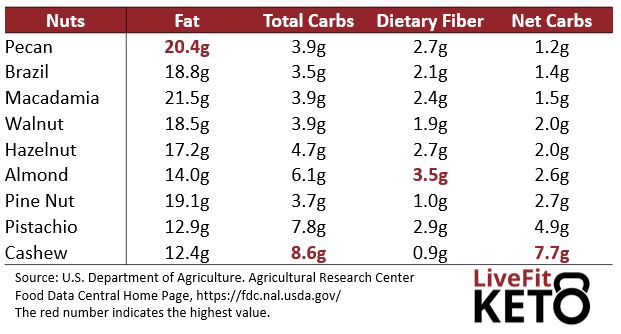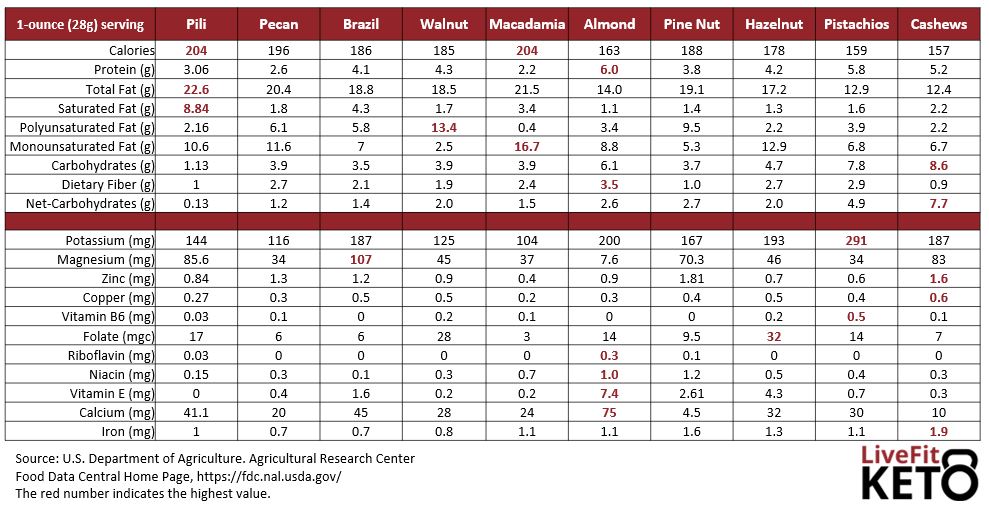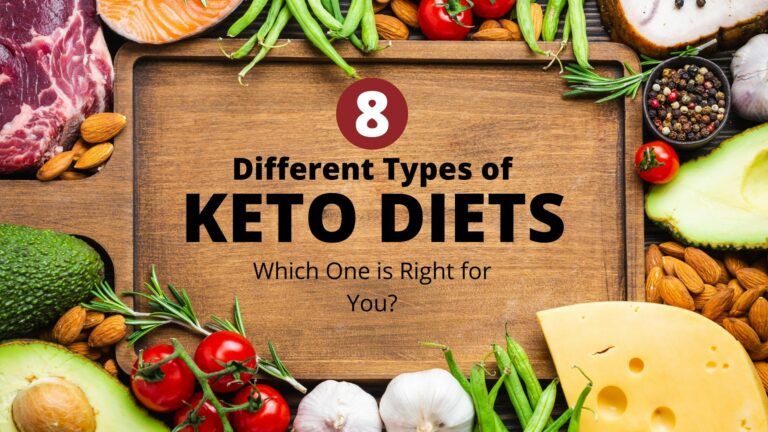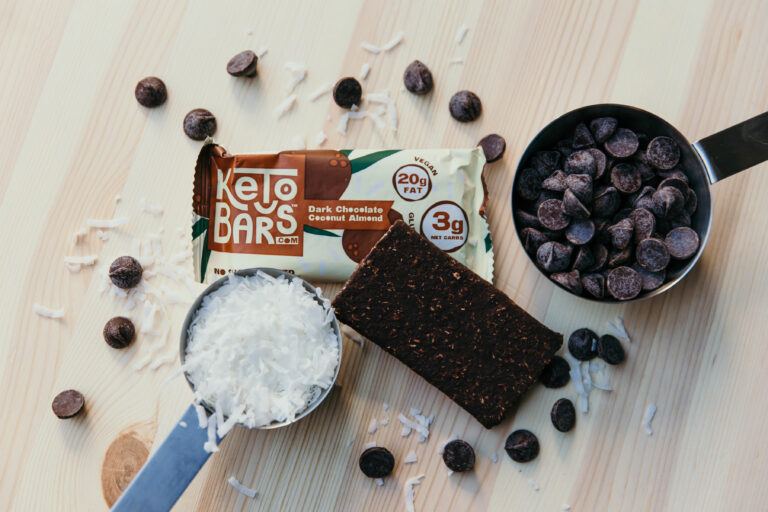Nuts On A Keto Diet – The 4 Healthiest Options
Nuts are a great addition to the ketogenic diet, however not all nuts are created equal, and some should be avoided altogether. Many nuts are “keto-approved” with respect to their fat, carb and protein content, but there is more to consider when selecting the best nuts for keto.
In this article we have provided a guide to selecting the best nuts to eat on a keto diet as well as a complete nut nutrition table.
Benefits of Eating Nuts
Nuts are extremely versatile. They can be eaten alone or easily added to salads, various dishes, baking or snack mixes, ground into flour or turned into nut butters. Nuts are high in nutrients, tasty, and extremely satisfying.
Many nuts are very high in fat and low in carbs, and can therefore be easily added to a meal or snack to ensure you are meeting your keto macronutrient requirements during each feeding. They are also relatively inexpensive, portable, and last a long time if stored in the refrigerator or freezer.
Selecting the Best Nuts for Keto
Despite their name, peanuts are not actually nuts, they belong to a different plant family called legumes which include beans, peas, lentils and soybeans. For the purpose of this article we will be examining the common tree nuts that you can find in your local grocery store.
Total & Net Carbs
Total carbs, and net carbs, are the first thing to look at when determining which nuts to consume on keto. Within a 1oz. serving, Brazil nuts are the lowest in total carbs, followed closely by pecans, walnuts and macadamia nuts. While cashews, pistachios, and almonds contain the most carbs.
When fiber is subtracted to calculate net carbs, the order changes only slightly. Since almonds are the highest in fiber, they shift closer to the middle of the pack.
Within the standard keto guidelines, the daily consumption of no more than 50g of total carbs, or 20g of net carbs is generally recommended. However, some people find it difficult to achieve and maintain ketosis using these guidelines, especially when first starting out.
If you are just starting keto, are having trouble maintaining ketosis, even after following keto long-term, or you have reached a weight loss plateau, you may want to consider lowering your total carbs to 20g or less.
Even though many nuts meet the macronutrient content guidelines for keto, it can be easy to overindulge. Due to their high fat content, eating too many can leave you feeling bloated or gassy and can overwhelm the gallbladder.
Nuts also contain certain amounts of “anti-nutrients” that can irritate the digestive system, especially in those who are particularly sensitive. A quarter cup of nuts, or single tablespoon of nut butter per meal is generally well tolerated. Consuming more than this could produce undesirable side effects.
Total & Net Carbs Per 1-ounce (28g) Serving of Nuts

Lectins
Lectins are a family of carbohydrate-binding proteins present in nearly all plants and animals. While animal lectins play various roles in normal physiological functions, plant lectins are believed to act as a defense mechanism against insects and other herbivores.
While certain lectins are toxic and can cause harm if consumed in excess, there doesn’t appear to be a clear consensus whether or not they should be avoided all together. Many nutritionists and doctors, including Dr. Steven Grundy, a former cardiac surgeon, believe that lectins contribute to gut permeability and drive autoimmune diseases.
Several other medical professionals however suggest that, in otherwise healthy individuals, lectins can be consumed in moderation without issue, and that cooking degrades most of the lectins in foods making them safe to consume.
Legumes, such as beans, soybeans, and peanuts, contain the highest amount of plant lectins, followed by grains and plants in the nightshade family. Consuming lectin rich foods, even after cooking, can irritate the digestive system and gallbladder in people that as sensitive to lectin.
A common symptom of an irritated gallbladder is pain along a nerve that runs from near the gallbladder up over the right shoulder. If you believe you have a gallbladder issue, or experience bloating, abdominal upset or discomfort after eating lectin rich foods, it may be best to eliminate these foods from your diet. It is important to note that any amount of bloating or digestive upset will halt weight loss.
Some nuts contain lots of lectins while other nuts have only small amounts. If you are experiencing right-sided symptoms or other gallbladder issues, selecting nuts low in lectins, or eliminating nuts altogether may be beneficial.
Nuts High In Lectins:
- Cashews
- Almonds
- Pine Nuts
- Hazelnuts
Nuts Low In Lectins:
- Pecans
- Walnuts
- Macadamia Nuts
- Pistachios
- Brazil Nuts
Oxalates
Oxalates are compounds found in many plant-based foods including some leafy greens, vegetables, fruits, cocoa, nuts and seeds. Once consumed, oxalates can bind to minerals such as calcium, and may create irritation in the kidneys. For sensitive individuals, diets high in oxalates can contribute to the formation of kidney stones.
Consuming apple cider vinegar, in capsule form, gummies, or simply diluted in water, can help prevent kidney stones from forming, and germinating nuts before eating them can help remove both oxalates and lectins.
Germination involves soaking nuts in water overnight and then dehydrating them at a low temperature. Heating or roasting nuts can also reduce these anti-nutrients, however high heat will also denature the healthy fats and proteins.
Nuts Highest in Oxalates:
- Almonds
- Cashews
- Pine Nuts
Nuts Lowest in Oxalates:
- Pecans
- Walnuts
- Macadamia Nuts
- Pistachios
Other Nutrients or Antinutrients
Phytic acid is present to varying degrees in grains, seeds, and nuts and can impair the absorption of iron, zinc, and calcium. Research has suggested that phytic acid does however have some health benefits, and should not be excluded altogether.
Soaking, spouting and fermentation can reduce the amount of phytic acid content of foods and make them easier to digest.
The Top 4 Nuts For Keto
Nuts are a great option on keto, but it is still important not to overindulge. When we take into consideration the fat and carb content, as well as the amount of nutrients, and anti-nutrients, the 4 best nuts for keto include:
- Pecans
- Brazil Nuts
- Walnuts
- Macadamia Nuts
Almonds, Pine Nuts, Hazel Nuts, and Pistachios are still good options to include, but perhaps in smaller amounts. Cashews are high in carbs and antinutrients, and should be avoided whenever possible.
Some of our favorite dairy-free products such as Miyoko’s Vegan Butter contain cashews. It is okay to consume a little here and there, but we prefer to keep it to a minimum.
What About Pili Nuts?
Pili nuts are higher in fat and lower in carbs than any other nut on our list, so why didn’t we include them? The short answer is that we have not been able to find any details on the lectin or oxalate content of pili nuts and therefore we felt it was best not to include them in this assessment.
We did however include them in the nut nutrition table below, we do consume them from time to time, and Pili Hunters is our favorite brand.
Complete Nut Nutrition Table

Do you agree with our list? Which nuts are your favorite? Please consider sharing your experience by commenting below in order to help others living a fit keto lifestyle.
Thank you for visiting LiveFitKeto.com. Check back often for new content or subscribe to our newsletter to receive updates on new articles, and if you have found this information helpful, please don’t hesitate to share.







